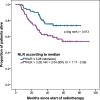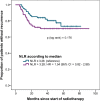Relation of baseline neutrophil-to-lymphocyte ratio to survival and toxicity in head and neck cancer patients treated with (chemo-) radiation
- PMID: 30400969
- PMCID: PMC6219022
- DOI: 10.1186/s13014-018-1159-y
Relation of baseline neutrophil-to-lymphocyte ratio to survival and toxicity in head and neck cancer patients treated with (chemo-) radiation
Abstract
Background: A high neutrophil-to-lymphocyte ratio (NLR) is a marker of systemic inflammation and together with the platelet-to-lymphocyte ratio (PLR) is associated with worse outcomes in several solid tumors. We investigated the prognostic value of NLR and PLR in patients with head and neck squamous cell carcinoma (HNSCC) treated with primary or adjuvant (chemo)radiotherapy ((C)RT).
Methods: A retrospective chart review of consecutive patients with HNSCC was performed. Neutrophil-to-lymphocyte ratio and PLR were computed using complete blood counts (CBCs) performed within 10 days before treatment start. The prognostic role of NLR and PLR was evaluated with univariable and multivariable Cox regression analyses adjusting for disease-specific prognostic factors. NLR and PLR were assessed as log-transformed continuous variables (log NLR and log PLR). Endpoints of interest were overall survival (OS), locoregional recurrence-free survival (LRFS), distant recurrence-free survival (DRFS), and acute toxicity.
Results: We analyzed 186 patients treated from 2007 to 2010. Primary sites were oropharynx (45%), oral cavity (28%), hypopharynx (14%), and larynx (13%). Median follow-up was 49 months. Higher NLR was associated with OS (adjusted HR per 1 unit higher log NLR = 1.81 (1.16-2.81), p = 0.012), whereas no association could be shown with LRFS (HR = 1.49 (0,83-2,68), p = 0.182), DRFS (HR = 1.38 (0.65-3.22), p = 0.4), or acute toxicity grade ≥ 2. PLR was not associated with outcome, nor with toxicity.
Conclusion: Our data suggest that in HNSCC patients treated with primary or adjuvant (C)RT, NLR is an independent predictor of mortality, but not disease-specific outcomes or toxicity. Neutrophil-to-lymphocyte ratio is a readily available biomarker that could improve pre-treatment prognostication and may be used for risk-stratification.
Keywords: Head and neck; Inflammation; Neutrophil-to-lymphocyte ratio; Platelet-to-lymphocyte ratio; Squamous cell carcinoma; Toxicity.
Conflict of interest statement
Ethics approval and consent to participate
All patients provided written consent for the use of their medical data for research purposes. Approval of the regional ethics committee (Kantonale Ethikkommission Bern – 289/2014) was obtained.
Consent for publication
All patients provided written consent for the publication of research performed with their medical data.
Competing interests
No potential conflicts of interests are to declare.
Publisher’s Note
Springer Nature remains neutral with regard to jurisdictional claims in published maps and institutional affiliations.
Figures
References
-
- Curado MP, Boyle P. Epidemiology of head and neck squamous cell carcinoma not related to tobacco or alcohol. Curr Opin Oncol. 2013;25(3):229–234. - PubMed
MeSH terms
Substances
LinkOut - more resources
Full Text Sources
Research Materials




